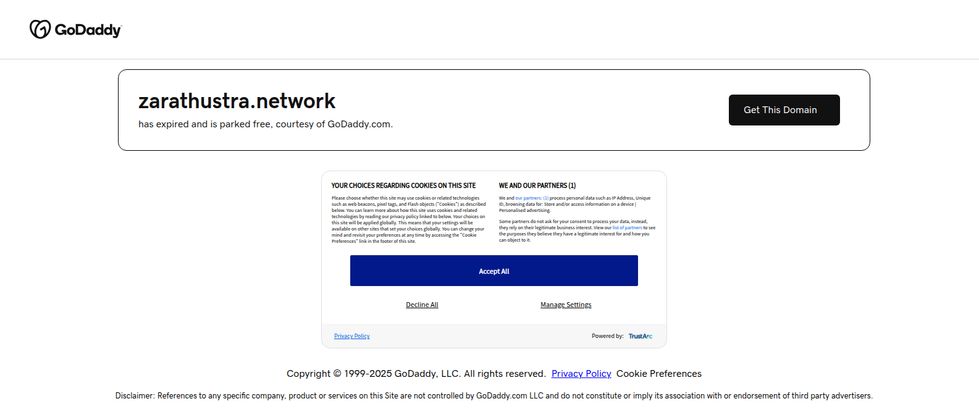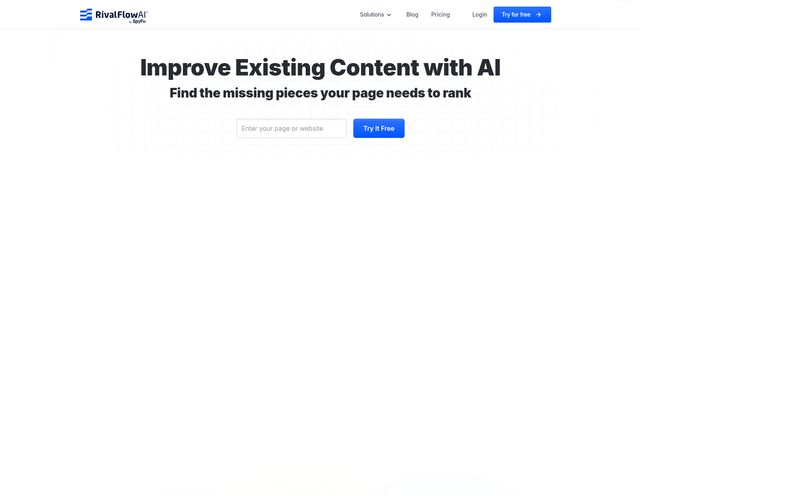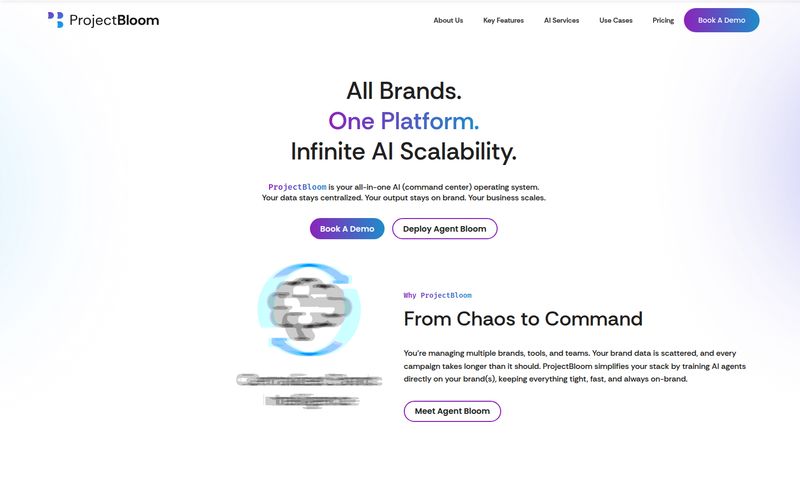As someone who lives and breathes SEO and digital marketing, my ears perk up whenever I hear about a new tool that promises to save time. Especially when that tool is free. So when the name 'Zarathustra' started bubbling up in a few marketing circles, I was intrigued. The promise was almost too good to be true: an AI tool that generates a detailed sales report on any company in under 60 seconds, just from a URL. No signup, no credit card, no funny business.
For a salesperson or a B2B marketer, that’s the holy grail. It’s the digital equivalent of a magic wand that instantly vanquishes the tedious, soul-crushing hours spent on pre-call research.
So, naturally, I fired up my browser, ready to take it for a spin. I typed in the address... and was met with a GoDaddy parked page. 'zarathustra.network has expired and is parked free of charge.'
Wait, what?
It was like showing up to a grand opening only to find the building has vanished. This sent me down a rabbit hole. What was this tool? Why was it so promising? And where in the world did it go? Let’s piece together the story of the ghost of a potentially genius sales tool.
The 60-Second Sales Report Dream
First off, a name like Zarathustra… that’s a bold choice. You're not calling your app 'SalesHelper 5000'. You're invoking a 19th-century philosophical novel by Nietzsche. It suggests ambition, a new way of thinking. I kind of respect it.
The core idea was beautifully simple. You, the busy salesperson, have a list of prospects. Instead of spending 20 minutes on each one—scrolling their LinkedIn, digging through their 'About Us' page, searching for recent news—you’d just paste their website link into Zarathustra. And less than a minute later, poof. A comprehensive report lands on your screen, ready to go.

Visit Zarathustra
This report wasn't just a data dump. It was designed to give you the exact ammunition you need for crafting hyper-personalized outreach. The kind of email that doesn't get immediately deleted. We’re talking about understanding a company's pain points, their recent successes, and their overall market position, all synthesized by AI. It was supposed to be a research assistant, a strategist, and a copywriter's muse all rolled into one.
Breaking Down the Barriers to Entry
Let's be honest, the biggest hurdle for trying any new SaaS tool is the friction. The sign-up form. The 'free trial' that demands a credit card. The endless onboarding emails. It’s exhausting.
Zarathustra's biggest selling point, in my opinion, was its complete lack of this friction for basic use. The ability to just show up and get value immediately is incredibly rare and powerful. It shows a deep confidence in the product—a 'here, just try it, you'll see' attitude that is so refreshing. In a world of lead-capture forms and marketing funnels, it was a tool built for the user first, and the marketer second. A subtle but important distinction.
A Closer Look at the Promised Features
So what was this magic report supposed to contain? Based on the information I could gather, it went beyond just scraping a homepage. It was about creating connections between disparate data points.
Beyond Just a Company Snapshot
Anyone can find a company's address or the name of their CEO. That's easy. The real challenge is understanding the narrative. What is this company trying to achieve? Did they just launch a new product line? Did they receive a round of Series B funding? Are they hiring aggressively for a specific department? These are the golden nuggets that turn a cold call into a warm conversation. Zarathustra promised to serve these nuggets up on a silver platter, saving you the trouble of panning for gold yourself.
The Personalization Angle
We all know that 'Hi [First Name]' doesn't count as personalization anymore. True personalization requires context. It’s the difference between saying "I sell SEO services" and "I saw you’re expanding your logistics division, and I have experience helping similar companies improve their organic visibility for supply chain keywords." One gets ignored, the other gets a reply. Zarathustra was built to facilitate the latter. It was a tool designed to combat the generic, spammy outreach that plagues all of our inboxes.
An Honest Look at the Pros and Cons (If You Could Use It)
Even in its spectral form, we can analyze the tool's theoretical strengths and weaknesses. No product is perfect, after all.
The upside was obvious and massive. We're talking about clawing back hours from your week, improving your conversion rates, and generally making the most draining part of sales—prospecting—significantly easier. The fact that it was fast and free? That's an unbeatable combination. It was democratizing sales intelligence, taking it out of the hands of enterprise teams with huge budgets and giving it to everyone.
But there were a few caveats. The information I found mentioned that more advanced features would require an account. Totally fair. You can't give away the whole farm for free forever. It also noted that the report's accuracy could be affected if you didn't provide additional context about your own company. This is the classic AI garbage-in, garbage-out problem. The tool can only be as smart as the information it's given. It’s a good remider that AI is a partner, not a mind-reader.
| The Good Stuff | The Potential Hitches |
|---|---|
| Saves a huge amount of research time. | Advanced features were likely behind a sign-up wall. |
| Generates reports in under a minute. | Report accuracy could depend on user input. |
| Completely free for basic use. | As we discovered... its existence is not guaranteed. |
| No signup needed to get started. | The name is a bit hard to spell. |
So, Where Did It Go?
This brings us back to the expired domain. What happens to a tool like this? I have a few theories, based on years of watching the tech space.
- The Acqui-hire: The team and technology were so good that a larger company (like a Salesforce or HubSpot) swooped in and bought them, not for the product, but for the talent. The original tool is shut down as the team gets integrated.
- Ran Out of Runway: Keeping even a 'free' AI tool running costs money for servers and APIs. The founders may have been self-funding and simply ran out of cash before they could properly monetize.
- A Passion Project: This could have been a side project for a few brilliant developers. It gained some traction, but they couldn't commit to turning it into a full-fledged business and eventually let it go.
- A Pivot: They might have taken their core technology and are now applying it to a different problem, or rebranding under a new name. Zarathustra was just the MVP (Minimum Viable Product).
It’s a classic story in the current AI gold rush. The barrier to creating something cool is lower than ever, but the barrier to building a sustainable business is as high as it's always been. One day you’re the next big thing, the next your domain is a digital tombstone courtesy of GoDaddy.
Frequently Asked Questions About Zarathustra
- What was Zarathustra AI?
- Zarathustra was an AI-powered tool designed to generate detailed sales intelligence reports from a company's URL in under 60 seconds. It was meant to help salespeople with research and personalized outreach.
- Was Zarathustra really free to use?
- Yes, from all available information, the core functionality of generating a basic report was free and did not require signing up. It's likely that more advanced features were planned to be part of a paid or premium tier.
- Why can't I access the zarathustra.network website?
- The domain name 'zarathustra.network' has expired and is currently parked by GoDaddy. This means the tool is not active or publicly available at this time. The project may have been discontinued, acquired, or pivoted.
- What are some good alternatives to Zarathustra for sales research?
- While nothing exactly matches its 'no-signup' model, there are many powerful sales intelligence platforms out there. Tools like Apollo.io, Hunter.io, and the built-in features of LinkedIn Sales Navigator offer deep company and contact research capabilities.
- How did Zarathustra help with personalized outreach?
- By quickly providing key insights—like recent funding, new product launches, or company news—it gave salespeople specific, relevant talking points to include in their emails and calls, making their outreach feel more informed and less generic.
- Is it common for new AI tools to disappear like this?
- Unfortunately, yes. The AI space is moving incredibly fast, and many tools are launched as experiments or by small teams with limited funding. It's quite common for projects to be abandoned or shut down, even if the initial idea is very promising.
A Final Word on a Tool That Was (Almost)
So, here's to Zarathustra. A great idea, a promising tool, and a potent reminder of how ephemeral things can be in the tech world. It addressed a very real pain point with an elegant solution. For a brief moment, it represented a better, faster way to do sales prospecting.
Perhaps it will be resurrected. Maybe it will reappear under a new name with a solid business model. Or maybe, its ghost will simply serve as inspiration for the next founder who is tired of spending hours on pre-call research. Either way, it was a fascinating case to investigate. The legend of the 60-second sales report will live on.
References and Sources
- GoDaddy (Domain Parking Services)
- Apollo.io (Sales Intelligence Platform)
- Hunter.io (Email Finding and Outreach Tool)



